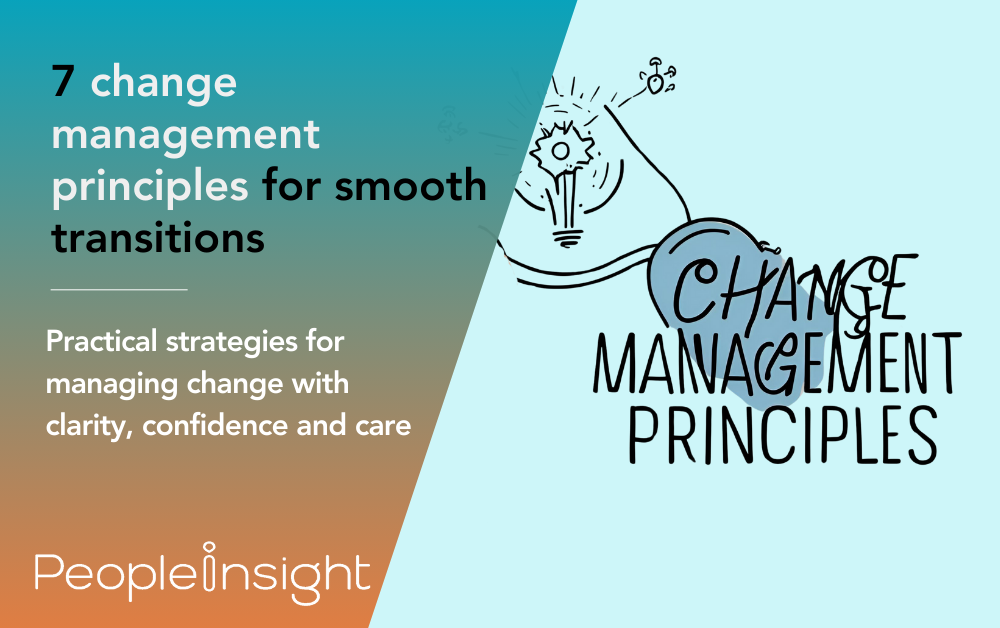
Change can disrupt progress, impact morale and trigger resistance — but it doesn’t have to. Leaders who approach transformation with care, clarity and purpose are far more likely to bring employees with them. Whether you’re reshaping strategy, introducing new tech or revising structures, how you manage the human side of change matters.
This is where change management principles make a tangible difference and therefore, should be kept at the forefront of your mind when leading change. These are the guiding practices that help organisations navigate transitions while protecting engagement, performance and trust.
However, our benchmark data reveals a challenge that’s too often overlooked — only 59% of employees across sectors believe that action will be taken following an employee survey. This indicates a widespread lack of confidence in leadership’s ability to act on feedback and deliver meaningful change. Without trust, even the most well-designed initiatives can lose momentum.
Related: What is change management?
No two change initiatives are exactly alike — but the following principles offer a framework to guide your approach, regardless of the situation.

Communication is the foundation of any successful change initiative. According to McKinsey, organisations that communicate clearly and consistently during change are 3.5 times more likely to outperform peers.
Start by explaining the ‘why’ behind the change — be transparent about the reasons, whether they’re strategic, financial or operational. Make the message personal by addressing how it affects different groups across the organisation.
Importantly, consistency matters. Mixed messages from different leaders lead to confusion. Equip managers with shared language, talking points and updates to keep everyone aligned.
Employees are more likely to accept — and even champion — change when they feel consulted and not merely informed. Involving people early on builds trust and encourages a sense of ownership.
Use a mix of methods to gather input: quick polls, change readiness assessments, listening sessions and anonymous change management surveys. Listening doesn’t mean handing over the reins, but it does help you understand barriers and issues before they grow into insurmountable problems.
Line managers are the front line of change. They translate high-level strategy into everyday conversations and decisions. Whether they’re confused or disengaged, their attitude trickles down fast.
Prepare managers with timely updates, simple toolkits and space to ask their own questions. Offer scenario planning or coaching for difficult conversations, so they’re not left guessing.
When managers feel confident with the change in question, employees are more likely to mirror that confidence.
Change affects more than processes — it affects people’s identity, confidence and routines. Some will embrace it, others hate any form of organisational change. Both are natural responses.
Leaders who acknowledge emotional reactions, rather than brushing them aside, create stronger relationships. Psychological safety plays a key role in navigating transition.
Promote honest conversations through informal check-ins and more formal support channels. Provide space for questions, even if you don’t yet have all the answers.
Employees want to understand how change connects to something bigger. If it feels like a short-term fix or a disconnected decision, it becomes harder to support.
Frame change in the context of your purpose and values. Share how it supports long-term priorities — whether that’s improving customer outcomes, becoming more sustainable or creating more opportunities for innovation.
When people see meaning in change, they’re more likely to stay committed.
Related: 7 Ways to support employees through workplace change
Even the best-laid plans need some tweaking now and then. Monitor how the change is being received and adapt where necessary. Avoid assumptions — what worked in one department or region may not work in another.
Use pulse surveys, open-text feedback, employee forums and change tracking tools to gather insight. Be clear about what’s being heard and how it’s shaping your next steps.
Importantly, act on what you find. Employees lose trust when they’re asked for feedback that leads nowhere.
Announcing a change is not the same as embedding it. To help new ways of working stick, they must be reinforced through daily routines, recognition and leadership behaviour.
Celebrate progress, however small. Recognise individuals and teams who are adopting new behaviours. Use internal communications to highlight practical examples of the change in action.
This not only reinforces expectations, but shows appreciation for those making the effort.
Good change management is ultimately about people. It’s not just about Gantt charts, milestones or process updates — it’s about listening, responding and guiding employees through uncertainty.
When organisations take the time to listen, they’re better placed to adapt and support their people meaningfully. That’s where employee surveys come in — not as a formality, but as a source of real-time insight to guide smart decisions.
If you’re planning change or managing one already, get in touch to discuss a tailored change management survey. It could be the difference between a bumpy rollout and a successful, satisfying transition.
